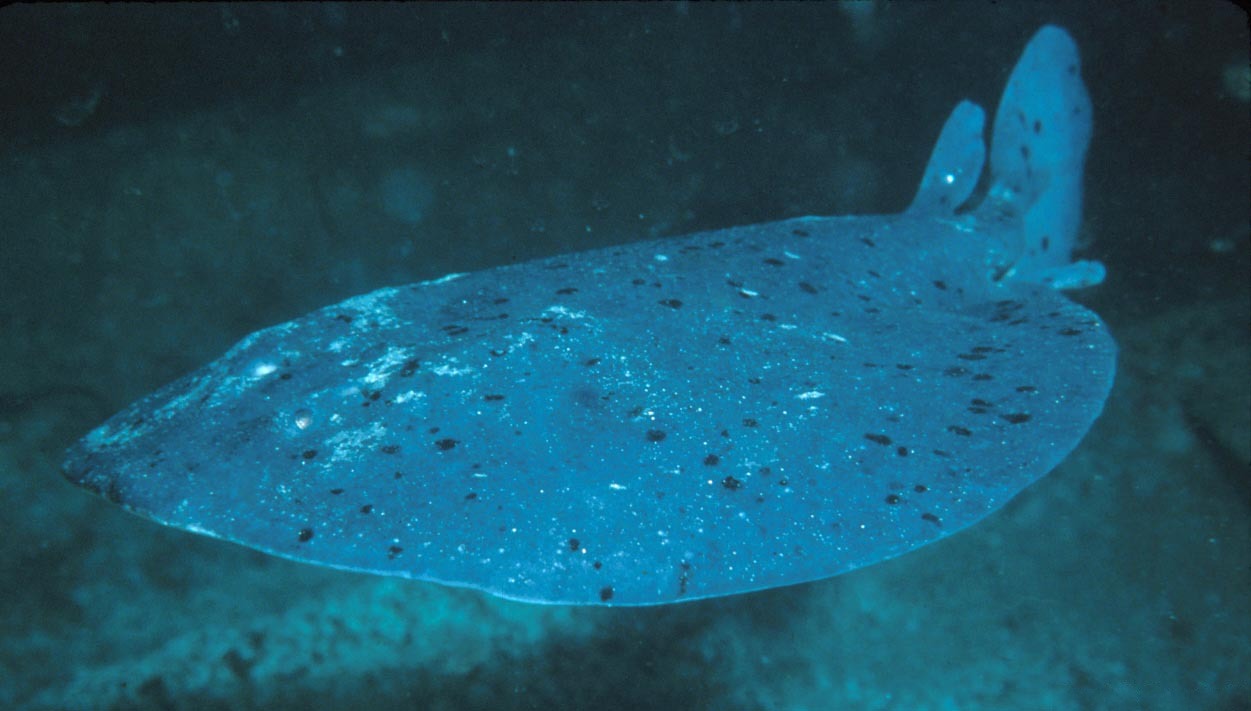- Torpedinidae
Taxobox
name = Torpedinidae

image_width = 240px
image_caption =Pacific electric ray , "Torpedo californica"
regnum =Animal ia
phylum = Chordata
classis =Chondrichthyes
subclassis =Elasmobranchii
ordo =Torpediniformes
familia = Torpedinidae
familia_authority = Bonaparte, 1838
subdivision_ranks = Genera
subdivision = "Hypnos" "Torpedo" See text for speciesThe family Torpedinidae contains 23 species of electric rays or torpedoes, flat cartilaginous fishes that produce
electricity as a defense and feeding mechanism. They are slow-moving bottom-dwellers.The largest species is the
Atlantic torpedo , "Torpedo nobiliana", which can grow to a weight of 90 kilograms and deliver a 220-volt electric shock. Electric rays have patches of modifiedmuscle cells called electroplaques that make up anelectric organ . These generate an electric gradient, similar to the normal electric potential across most cell membranes, but amplified greatly by its concentration into a very small area. The electricity can be stored in the tissues, which act as a battery. The shock can be discharged in pulses. A ray can emit a shock into the body of a prey animal to stun it and make it easier to capture and eat, or into the body of a predator. Tissue from electric rays is often used in neurobiological research because of its unique properties.Torpedo rays are flat like other rays, disc-shaped, with caudal fins that vary in length. Their mouths and gill slits are located on their undersides. Males have
clasper s near the base of the tail. Females are ovoviviparous, meaning they form eggs but do not lay them. The young emerge from the eggs within the body of the female, and she gives live birth. The young are called "pups".The naval weapon known as the
torpedo was named after this genus, whose own name has the sameLatin origin as the English word "torpid," meaning "sluggish" or "lethargic," presumably the sensations one would feel after experiencing the ray's electric shock.pecies
There are 23 species in two genera:
* Genus "Hypnos"
**Coffin ray , "Hypnos monopterygium " (Shaw, 1795).
* Genus "Torpedo"
** "Torpedo adenensis " Carvalho, Stehmann & Manilo, 2002.
**Alexandrine torpedo , "Torpedo alexandrinsis " Mazhar, 1987.
**Florida torpedo , "Torpedo andersoni " Bullis, 1962.
**Rosette torpedo , "Torpedo bauchotae " Cadenat, Capape & Desoutter, 1978.
**Pacific electric ray , "Torpedo californica " Ayres, 1855.
**New Zealand torpedo , "Torpedo fairchildi " Hutton, 1872.
** "Torpedo formosa " Haas & Ebert, 2006.
**Black-spotted torpedo , "Torpedo fuscomaculata " Peters, 1855.
**Ringed torpedo , "Torpedo mackayana " Metzelaar, 1919.
**Shorttail torpedo , "Torpedo macneilli " (Whitley, 1932).
**Spotted torpedo , "Torpedo marmorata " Risso, 1810.
**Smalldisk torpedo , "Torpedo microdiscus " Parin & Kotlyar, 1985.
**Atlantic torpedo , "Torpedo nobiliana " Bonaparte, 1835.
**Panther electric ray , "Torpedo panthera " Olfers, 1831.
**Peruvian torpedo , "Torpedo peruana " Chirichigno F., 1963.
**Argentine torpedo , "Torpedo puelcha " Lahille, 1926.
**Semipelagic torpedo , "Torpedo semipelagica " Parin & Kotlyar, 1985.
**Marbled electric ray , "Torpedo sinuspersici " Olfers, 1831.
** "Torpedo suessii " Steindachner, 1898.
**Trapezoid torpedo , "Torpedo tokionis " (Tanaka, 1908).
**Common torpedo , "Torpedo torpedo " (Linnaeus, 1758).
** Torpedo, "Torpedo tremens " de Buen, 1959.References
*
External links
* [http://www.scubageek.com/articles/wwwray.html How Torpediniform Rays Generate Electric Fields]
Wikimedia Foundation. 2010.
